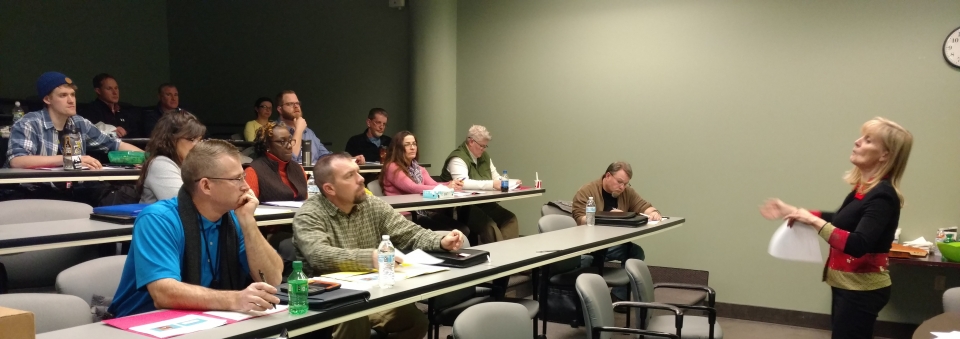NATIONAL ATR NETWORK SURVEY
Hundreds of ACEs, trauma, & resilience networks across the country responded to our survey. See what they shared about network characteristics, goals, and technical assistance needs.
In 2011, a county-wide training on trauma, hosted by Crawford County Human Services and attended by 150 professionals, yielded curiosity, a brief ripple of enthusiasm and…not much else.
Two years later, another Crawford conference—this time, drawing 170 professionals and service providers, family members and youth—became a catalyst, a key moment in the genesis of Peace4Crawford, a cross-sector, grass-roots movement to build a healthy and resilient community in the western Pennsylvania county.
The difference, according to Peace4Crawford steering committee members, is that by the time of the second conference, social service agencies, the juvenile probation department, drug and alcohol recovery center and schools had begun to collaborate, using the shared language of adverse childhood experiences (ACEs) and resilience to plumb the root causes of the disparate problems all were seeing.
When Crawford County Human Services (CCHS) became a Pennsylvania System of Care Partner in 2013, representatives of human service agencies and clients of those agencies came together to develop a coordinated system of services that was strength-based, youth-driven and trauma-informed.
“The one thing that resonated with everybody was the discussion about trauma,” says Joe Barnhart, system of care manager for CCHS. Trauma was the common thread that linked student behavior problems, adult drug addictions, domestic and sexual violence and child welfare issues.
“The ACEs study was a game-changer for me,” says Bruce Harlan, executive director of Crawford’s Women’s Services, Inc., which works with survivors of domestic and sexual violence. “We were already having conversations around pooling resources and leveraging one another’s strengths. The ACEs piece was a natural catalyst for focusing our efforts and creating a singularity of vision and purpose. I was glad to be part of a community that rallied around this.”
Today, in a county with a population nearing 86,000, Peace4Crawford—inspired by and modeled after Peace4Tarpon in Tarpon Springs, Florida—draws about twenty people to its informal monthly meetings. Discussions at those meetings have led to innovative projects:
a series of dialogues called “courageous conversations” in response to police shootings around the country;
“mental health cafés” in coffee shops;
a data collection effort, in partnership with Allegheny College, to identify county “hotspots” that experience high rates of poverty, opioid overdoses and 911 calls.
With mental health services provider Parkside Psychological Associates, CCHS and other Peace4Crawford partners trained 56 volunteers to present overviews of ACEs, trauma and resilience to community groups and organizations. To date, 7,000 people have received those trainings. In collaboration with Erie County, Peace4Crawford hosts an annual trauma-informed/community-building conference—a nationally-known speaker, plus workshops—that draws 300 people.

Barnhart and Harlan cite other fruits of Peace4Crawford’s cross-sector collaboration, including a trauma self-assessment and planning protocol in 2015-16 that involved two high schools and three social service agencies, the juvenile probation department and county drug and alcohol treatment office. Service providers, courts and some faith groups have joined the network’s efforts, along with area hospitals and colleges. Barnhart notes that focusing on vicarious trauma has proven an effective way to engage teachers and human service providers in Crawford’s resilience-building work. He and Harlan would like to see more involvement from the business community and law enforcement; they are planning a training for first responders.
In 2017, Peace4Crawford’s strategic planning committee analyzed the network’s strengths and limitations, clarified its core values (collaborative, integrative, preventative and generative) and set goals that include awareness, training, screening/intervention and prevention/advocacy.
The data mapping effort—along with exposure to the concept of trauma-informed community development at a training developed by FOCUS Pittsburgh—led to a “micro-neighborhood” project in Meadville, the county seat, an intensive effort involving door-to-door conversations and meetings to help residents identify local problems and co-create solutions to them. Already, that project, called the H.O.P.E. Initiative (health and wellness; opportunity-making, place-making, engaging influencers) is yielding results, with more residents showing up to local government hearings and making face-to-face connections through neighborhood events.
“We’d like to continue to work on the micro-neighborhood level and see if we can make a change fundamentally,” says Barnhart. “The key to success is starting off with decent relationships. I don’t think we could have accomplished much of anything without the connections.”
Learn more about Peace4Crawford by visiting their website or Facebook page.
Learn more about H.O.P.E. Meadville by visiting their Facebook page.
Anndee Hochman is a journalist and author whose work appears regularly in The Philadelphia Inquirer, on the website for public radio station WHYY and in other print and online venues. She teaches poetry and creative non-fiction in schools, senior centers, detention facilities and at writers' conferences.
